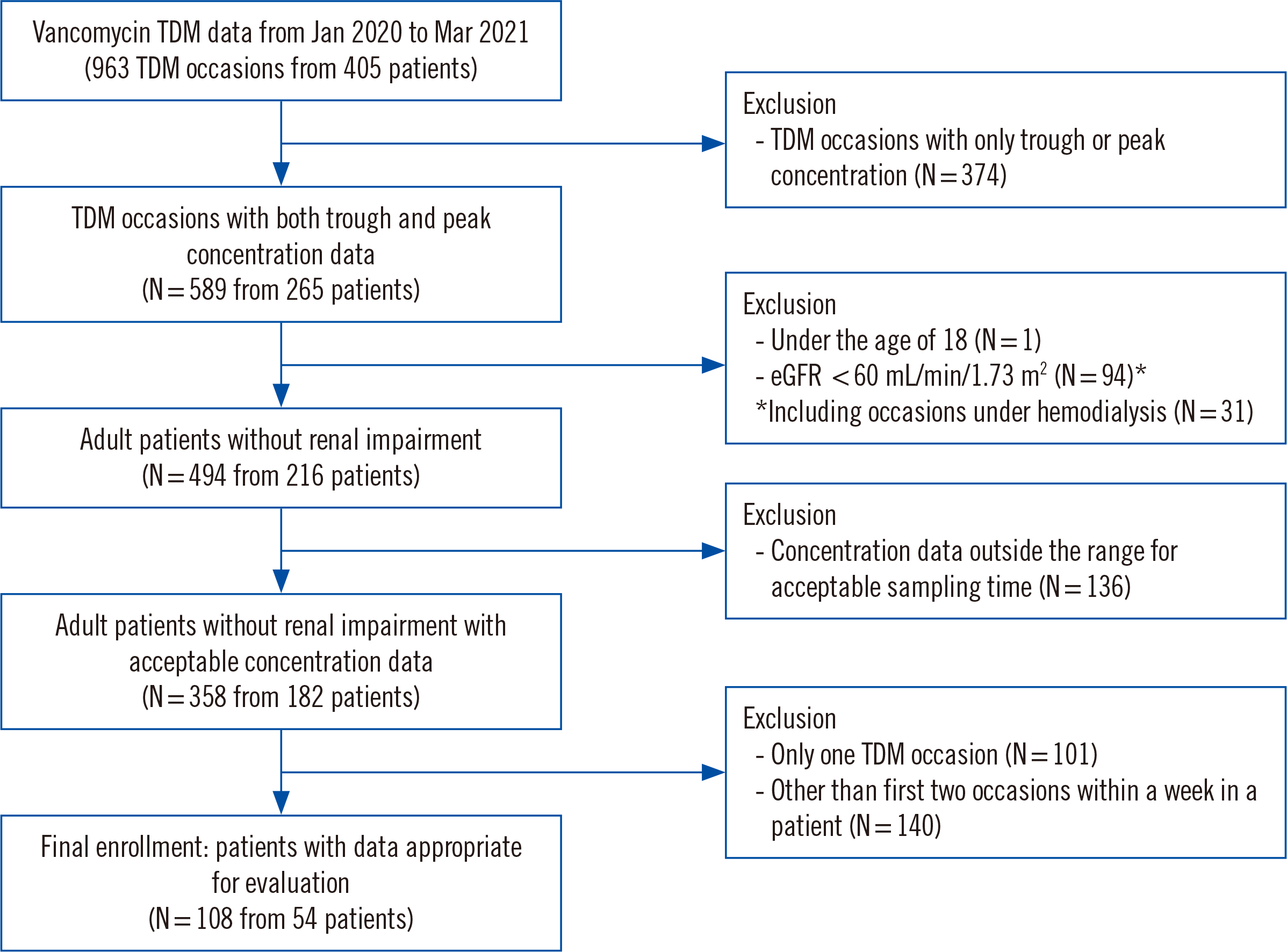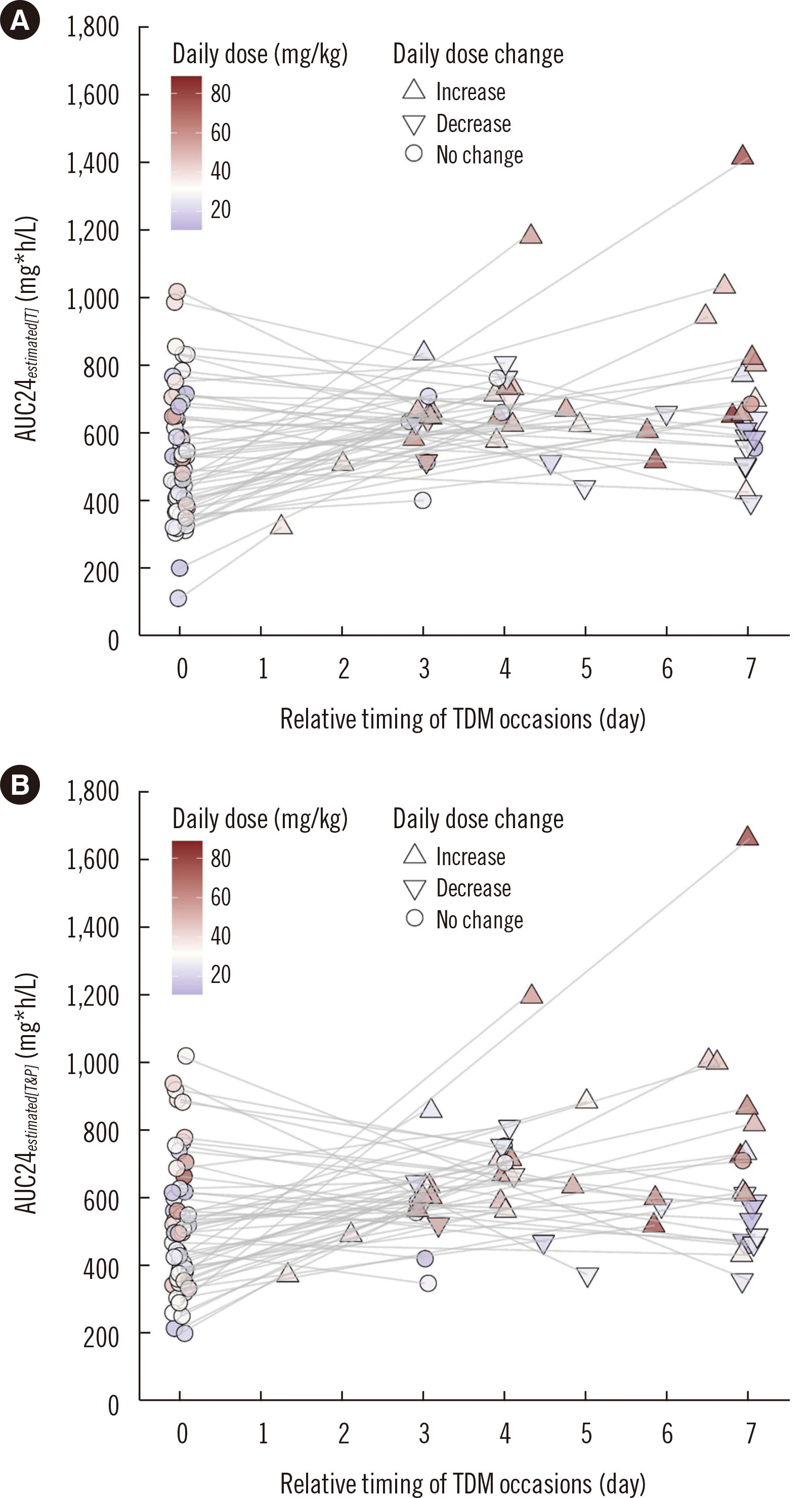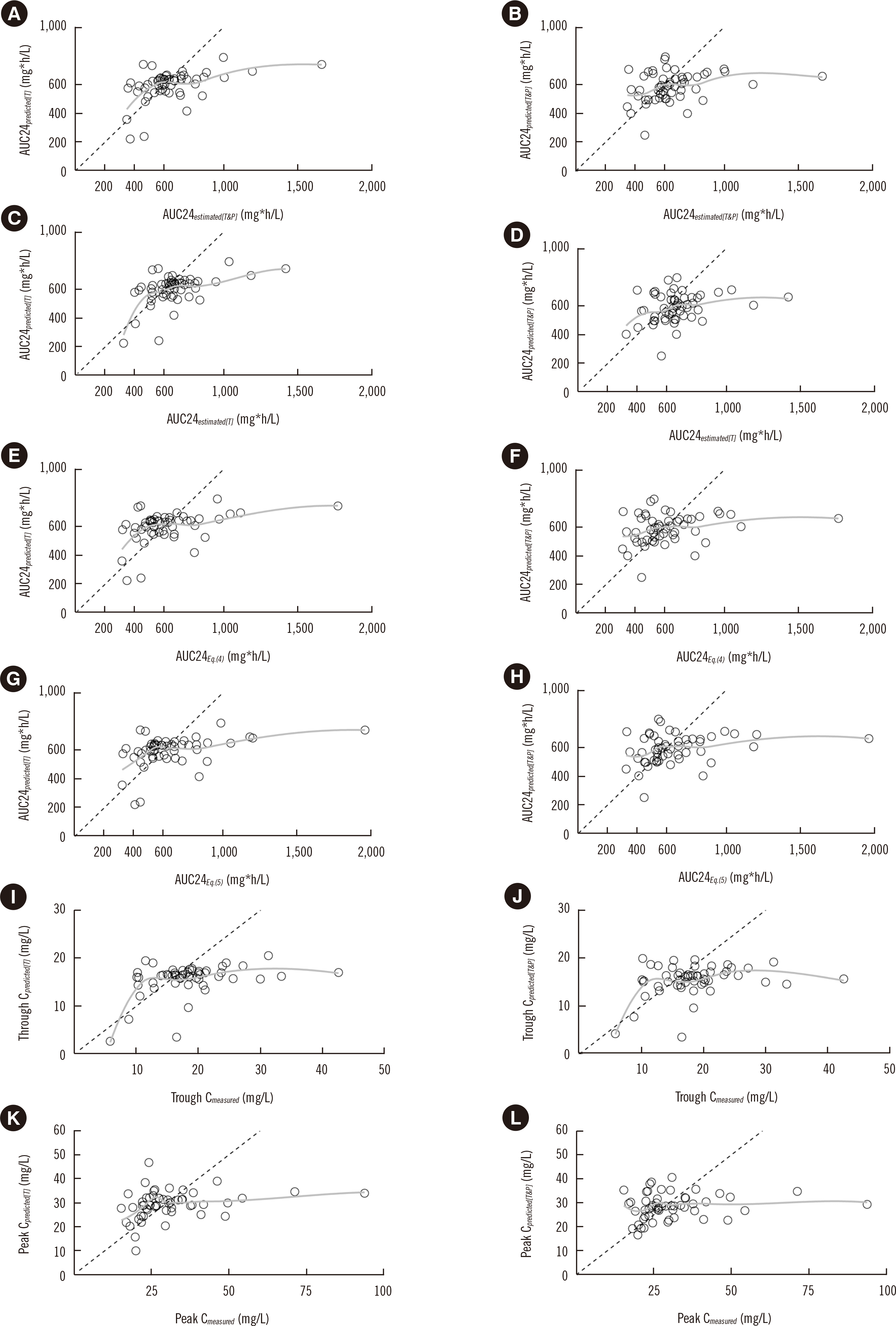1. Turner NA, Sharma-Kuinkel BK, Maskarinec SA, Eichenberger EM, Shah PP, Carugati M, et al. 2019; Methicillin-resistant
Staphylococcus aureus: an overview of basic and clinical research. Nat Rev Microbiol. 17:203–18. DOI:
10.1038/s41579-018-0147-4. PMID:
30737488. PMCID:
PMC6939889.

2. Rybak M, Lomaestro B, Rotschafer JC, Moellering R Jr, Craig W, Billeter M, et al. 2009; Therapeutic monitoring of vancomycin in adult patients: a consensus review of the American Society of Health-System Pharmacists, the Infectious Diseases Society of America, and the Society of Infectious Diseases Pharmacists. Am J Health Syst Pharm. 66:82–98. DOI:
10.2146/ajhp080434. PMID:
19106348.

3. Revilla N, Martín-Suárez A, Pérez MP, González Gonzalez FM, Fernández de Gatta MM. 2010; Vancomycin dosing assessment in intensive care unit patients based on a population pharmacokinetic/pharmacodynamic simulation. Br J Clin Pharmacol. 70:201–12. DOI:
10.1111/j.1365-2125.2010.03679.x. PMID:
20653673. PMCID:
PMC2911550.

4. Rybak MJ, Le J, Lodise TP, Levine DP, Bradley JS, Liu C, et al. 2020; Therapeutic monitoring of vancomycin for serious methicillin-resistant
Staphylococcus aureus infections: a revised consensus guideline and review by the American Society of Health-System Pharmacists, the Infectious Diseases Society of America, the Pediatric Infectious Diseases Society, and the Society of Infectious Diseases Pharmacists. Am J Health Syst Pharm. 77:835–64. DOI:
10.1093/ajhp/zxaa036. PMID:
32191793.
5. Reuter SE, Stocker SL, Alffenaar JC, Baldelli S, Cattaneo D, Jones G, et al. 2022; Optimal practice for vancomycin therapeutic drug monitoring: position statement from the Anti-Infectives Committee of the International Association of Therapeutic Drug Monitoring and Clinical Toxicology. Ther Drug Monit. 44:121–32. DOI:
10.1097/FTD.0000000000000944. PMID:
34882107.

6. van der Meer AF, Touw DJ, Marcus MA, Neef C, Proost JH. 2012; Influence of erroneous patient records on population pharmacokinetic modeling and individual bayesian estimation. Ther Drug Monit. 34:526–34. DOI:
10.1097/FTD.0b013e3182616937. PMID:
22846895.

7. Matsumoto K, Oda K, Shoji K, Hanai Y, Takahashi Y, Fujii S, et al. 2022; Clinical practice guidelines for therapeutic drug monitoring of vancomycin in the framework of model-informed precision dosing: a consensus review by the Japanese society of chemotherapy and the Japanese society of therapeutic drug monitoring. Pharmaceutics. 14:489. DOI:
10.3390/pharmaceutics14030489. PMID:
35335866. PMCID:
PMC8955715.

8. Neely MN, Youn G, Jones B, Jelliffe RW, Drusano GL, Rodvold KA, et al. 2014; Are vancomycin trough concentrations adequate for optimal dosing? Antimicrob Agents Chemother. 58:309–16. DOI:
10.1128/AAC.01653-13. PMID:
24165176. PMCID:
PMC3910745.

9. Turner RB, Kojiro K, Shephard EA, Won R, Chang E, Chan D, et al. 2018; Review and validation of bayesian dose-optimizing software and equations for calculation of the vancomycin area under the curve in critically ill patients. Pharmacotherapy. 38:1174–83. DOI:
10.1002/phar.2191. PMID:
30362592.

10. Oda K, Hashiguchi Y, Kimura T, Tsuji Y, Shoji K, Takahashi Y, et al. 2021; Performance of area under the concentration-time curve estimations of vancomycin with limited sampling by a newly developed web application. Pharm Res. 38:637–46. DOI:
10.1007/s11095-021-03030-y. PMID:
33782837.

11. Alsowaida YS, Kubiak DW, Dionne B, Kovacevic MP, Pearson JC. 2022; Vancomycin area under the concentration-time curve estimation using bayesian modeling versus first-order pharmacokinetic equations: a quasi-experimental study. Antibiotics (Basel). 11:1239. DOI:
10.3390/antibiotics11091239. PMID:
36140021. PMCID:
PMC9495010.

13. Pai MP, Neely M, Rodvold KA, Lodise TP. 2014; Innovative approaches to optimizing the delivery of vancomycin in individual patients. Adv Drug Deliv Rev. 77:50–7. DOI:
10.1016/j.addr.2014.05.016. PMID:
24910345.

14. Neef C, Touw DJ, Harteveld AR, Eerland JJ, Uges DR. 2006; Pitfalls in TDM of antibiotic drugs: analytical and modelling issues. Ther Drug Monit. 28:686–9. DOI:
10.1097/01.ftd.0000243966.97964.11. PMID:
17038886.

15. Cockcroft DW, Gault MH. 1976; Prediction of creatinine clearance from serum creatinine. Nephron. 16:31–41. DOI:
10.1159/000180580. PMID:
1244564.

17. Jelliffe RW, Schumitzky A, Guilder M. 1992; Nonpharmacokinetic clinical factors affecting aminoglycoside therapeutic precision. Drug Invest. 4:20–9. DOI:
10.1007/BF03258374.

18. Alihodzic D, Broeker A, Baehr M, Kluge S, Langebrake C, Wicha SG. 2020; Impact of inaccurate documentation of sampling and infusion time in model-informed precision dosing. Front Pharmacol. 11:172. DOI:
10.3389/fphar.2020.00172. PMID:
32194411. PMCID:
PMC7063976.

19. Olney KB, Wallace KL, Mynatt RP, Burgess DS, Grieves K, Willett A, et al. 2022; Comparison of Bayesian-derived and first-order analytic equations for calculation of vancomycin area under the curve. Pharmacotherapy. 42:284–91. DOI:
10.1002/phar.2670. PMID:
35134264. PMCID:
PMC9750735.

20. Narayan SW, Thoma Y, Drennan PG, Yejin Kim H, Alffenaar JW, Van Hal S, et al. 2021; Predictive performance of bayesian vancomycin monitoring in the critically Ill. Crit Care Med. 49:e952–e60. DOI:
10.1097/CCM.0000000000005062. PMID:
33938713.

21. Cunio CB, Uster DW, Carland JE, Buscher H, Liu Z, Brett J, et al. 2020; Towards precision dosing of vancomycin in critically ill patients: an evaluation of the predictive performance of pharmacometric models in ICU patients. Clin Microbiol Infect. 27:S1198-743X(20)30388-8783e7-e14. DOI:
10.1016/j.cmi.2020.07.005. PMID:
32673799.

22. Broeker A, Nardecchia M, Klinker KP, Derendorf H, Day RO, Marriott DJ, et al. 2019; Towards precision dosing of vancomycin: a systematic evaluation of pharmacometric models for Bayesian forecasting. Clin Microbiol Infect. 25:1286.e1–e7. DOI:
10.1016/j.cmi.2019.02.029. PMID:
30872102.

23. Roydhouse SA, Carland JE, Debono DS, Baysari MT, Reuter SE, Staciwa AJ, et al. 2021; Accuracy of documented administration times for intravenous antimicrobial drugs and impact on dosing decisions. Br J Clin Pharmacol. 87:4273–82. DOI:
10.1111/bcp.14844. PMID:
33792079.

24. Melanson SEF, Mijailovic AS, Wright APM, Szumita PM, Bates DW, Tanasijevic MJ. 2013; An intervention to improve the timing of vancomycin levels. Am J Clin Pathol. 140:801–6. DOI:
10.1309/AJCPKQ6EAH7OYQLB. PMID:
24225746.

25. Neely MN, Kato L, Youn G, Kraler L, Bayard D, van Guilder M, et al. 2018; Prospective trial on the use of trough concentration versus area under the curve to determine therapeutic vancomycin dosing. Antimicrob Agents Chemother. 62:e02042–17. DOI:
10.1128/AAC.02042-17. PMID:
29203493. PMCID:
PMC5786789.

26. Brocks DR, Hamdy DA. 2020; Bayesian estimation of pharmacokinetic parameters: an important component to include in the teaching of clinical pharmacokinetics and therapeutic drug monitoring. Res Pharm Sci. 15:503–14. DOI:
10.4103/1735-5362.301335. PMID:
33828594. PMCID:
PMC8020855.

27. Kim HK, Park HD, Lee SG, Chae H, Song SH, Lee YW, et al. 2021; Immunosuppressive drug measurement by liquid chromatography coupled to tandem mass spectrometry: interlaboratory comparison in the Korean clinical laboratories. Ann Lab Med. 41:268–76. DOI:
10.3343/alm.2021.41.3.268. PMID:
33303711. PMCID:
PMC7748092.

28. Choi R, Chun MR, Park J, Lee JW, Ju HY, Cho HW, et al. 2021; Quantification of thioguanine in DNA using liquid chromatography-tandem mass spectrometry for routine thiopurine drug monitoring in patients with pediatric acute lymphoblastic leukemia. Ann Lab Med. 41:145–54. DOI:
10.3343/alm.2021.41.2.145. PMID:
33063676. PMCID:
PMC7591283.

29. Sonoda A, Iwashita Y, Takada Y, Hamazono R, Ishida K, Imamura H. 2022; Prediction accuracy of area under the concentration-time curve of vancomycin by Bayesian approach using creatinine-based equations of estimated kidney function in bedridden elderly Japanese patients. Biol Pharm Bull. 45:763–9. DOI:
10.1248/bpb.b22-00070. PMID:
35370223.

30. Choi R, Woo HI, Park HD, Lee SY. 2019; A nationwide utilization survey of therapeutic drug monitoring for five antibiotics in South Korea. Infect Drug Resist. 12:2163–73. DOI:
10.2147/IDR.S208783. PMID:
31410036. PMCID:
PMC6646174.
31. Lim HS, Chong YP, Noh YH, Jung JA, Kim YS. 2014; Exploration of optimal dosing regimens of vancomycin in patients infected with methicillin-resistant
Staphylococcus aureus by modeling and simulation. J Clin Pharm Ther. 39:196–203. DOI:
10.1111/jcpt.12123. PMID:
24428720.

32. Kim DJ, Lee DH, Ahn S, Jung J, Kiem S, Kim SW, et al. 2019; A new population pharmacokinetic model for vancomycin in patients with variable renal function: therapeutic drug monitoring based on extended covariate model using CKD-EPI estimation. J Clin Pharm Ther. 44:750–9. DOI:
10.1111/jcpt.12995. PMID:
31228353.

33. Bae SH, Yim DS, Lee H, Park AR, Kwon JE, Sumiko H, et al. Application of pharmacometrics in pharmacotherapy: open-source software for vancomycin therapeutic drug management. Pharmaceutics. 2019; 11:DOI:
10.3390/pharmaceutics11050224. PMID:
31075931. PMCID:
PMC6572512.

34. Lee BV, Fong G, Bolaris M, Neely M, Minejima E, Kang A, et al. 2021; Cost-benefit analysis comparing trough, two-level AUC and Bayesian AUC dosing for vancomycin. Clin Microbiol Infect. 27:1346.e1–e7. DOI:
10.1016/j.cmi.2020.11.008. PMID:
33221430.








 PDF
PDF Citation
Citation Print
Print



 XML Download
XML Download